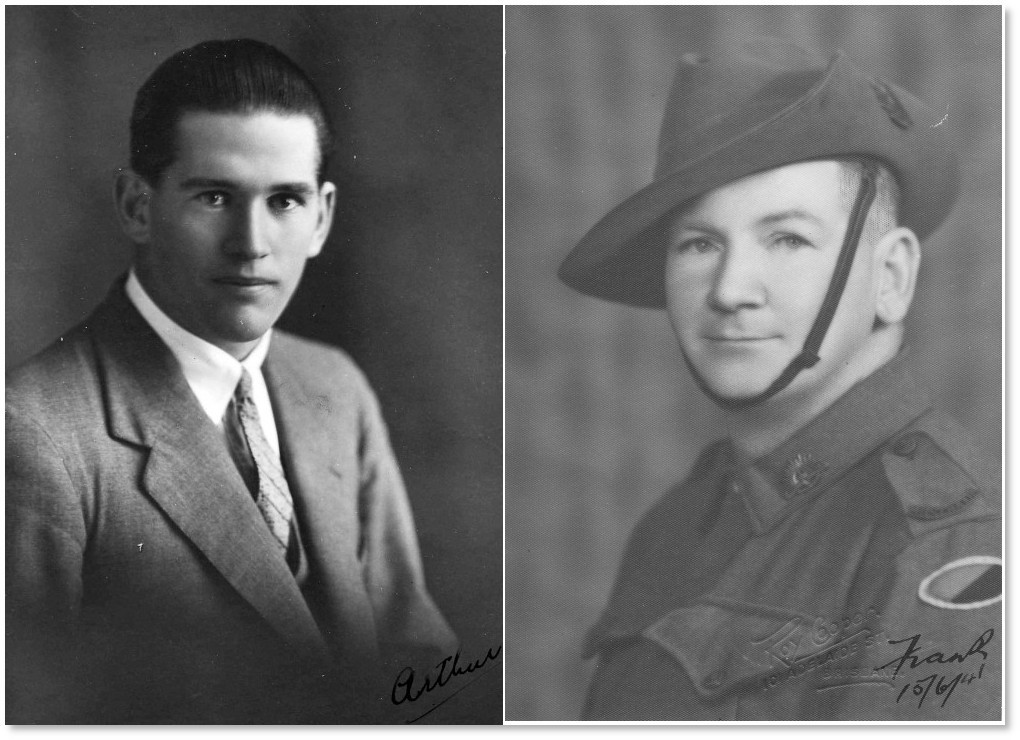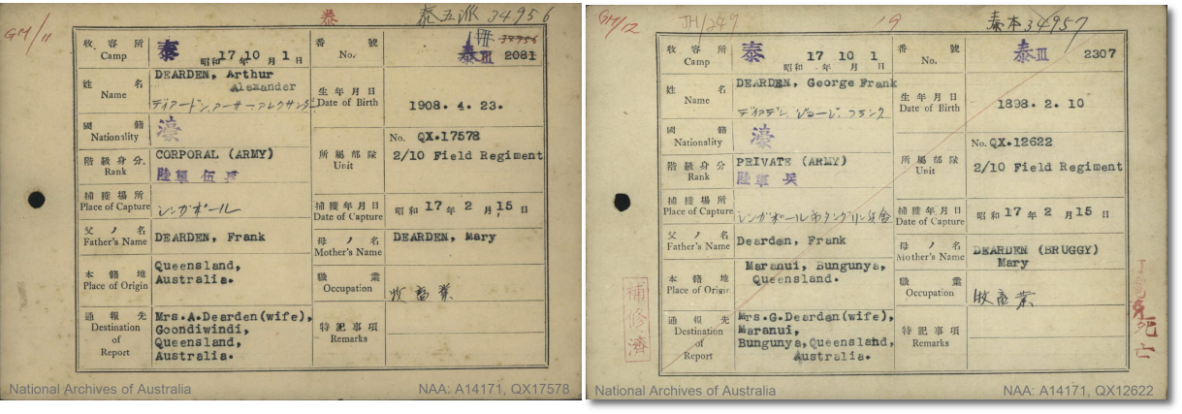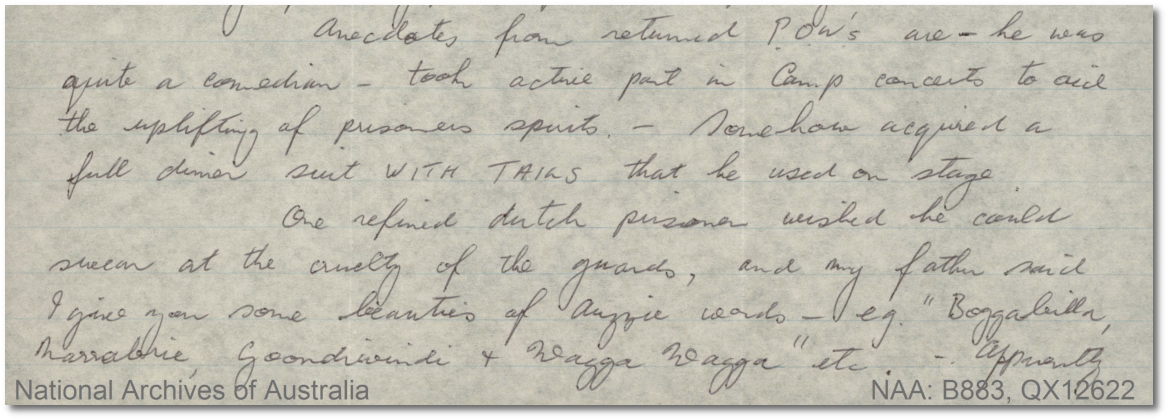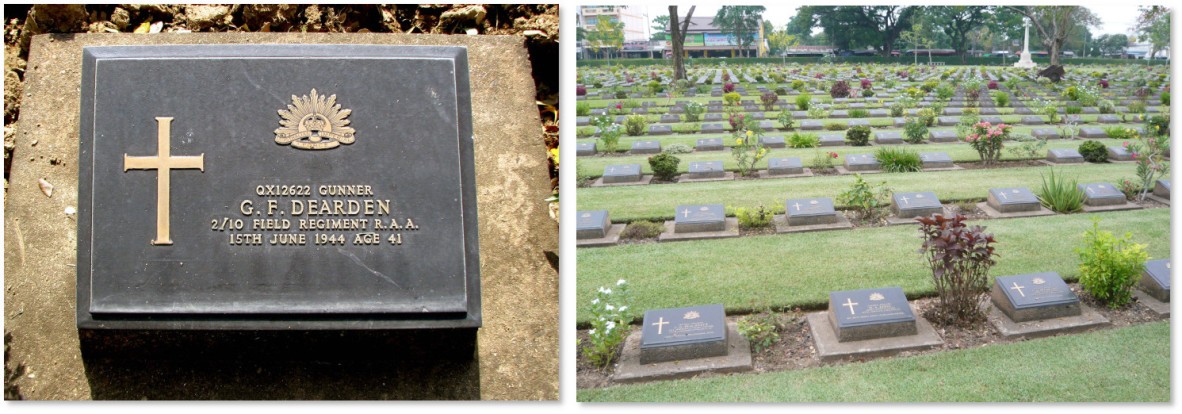Frank and Alex Dearden, 2/10th Field Regiment
By Marg Powell, Specialist Library Technician, Metadata Services | 16 March 2024
George 'Frank' Dearden and his younger brother Arthur 'Alex' both served with the 2/10th Field Regiment during the Second World War, both were taken prisoner by the Japanese during the Fall of Singapore in February 1942 and both laboured on the Burma-Thailand railway, only one returned.

Arthur 'Alex' Dearden, left; George 'Frank' Dearden, right. Images courtesy of the Dearden Family
The 2/10th was deployed to Malaya in 1941 and prepared defences in Mersing, Jemaluang, Kota Tingi and Jahore, constructing bridges and water supplies, and later construction of operating theatres, laying of minefields and establishment of other defences. As the Imperial Japanese Forces moved rapidly down the Malay Peninsula, troops were evacuated and bridges destroyed in an attempt to stop their advance.
The engineers were deployed to fight alongside and support the infantry battalions and although much of their efforts were successful, they were not able to sustain them. By 15 February 80,000 allied troops became prisoners of war.

Japanese Prisoner of War, index cards for Alex Dearden and Frank Dearden. Images courtesy National Archives of Australia.
Frank and Alex were both held in Changi Prison, before being detached to 'A Force' - Anderson Force in May 1943 and left Singapore aboard the Toyohashi Maru, off loading at Tavoy in Burma. After a few months they moved to Moulmein (Mawlamyine) and south to Thanbyuzayat, to work on the Burma end of the infamous Burma-Thailand Railway. The brothers were separated when Arthur's eyesight failed due to malnutrition. Frank managed to return to Arthur's camp, working in the kitchens and butchers shop, taking the 'discarded' cuts to make soup for the most seriously ill, before sharing it with others as much as he was able.

Extract of letter written by Frank's daughter Fay, to the Australian Army Medal Service in 1999. National Archives of Australia. Series B883, Item ID 4499636, page 17
Frank returned to work on the railway but met up with Alex at Nikki Camp where the two railways were joined. In December 1943 after it was completed, Frank went to Tamarkan Camp, and Alex to Kanburi (Kanchanaburi), 5 km apart. Alex received word that Frank was very ill with dysentery and was given permission to visit his camp, he walked the 5km with an ulcerous leg. Alex later wrote "his joy at my arrival is a memory I shall cherish till it's my turn to pass on". Alex was with Frank for six days before he died, and attended his funeral at the prisoners cemetery at Tamarkan.

Australian Red Cross Society - Missing, Wounded and Prisoner of War Enquiry Cards, for A.A. and G.F. Dearden. Images courtesy of The University of Melbourne archives.
Their mother Mary Ann made enquiries via the Australian Red Cross Wounded and Missing Bureau who advised that her sons had been confirmed POW's in Burma and later Thailand. She was also advised in June 1945 of Frank's death the previous year in June 1944, of dysentery, and that Alex was alive.
While waiting for his repatriation from Thailand in September 1945, Alex wrote to his family relating the circumstances of Frank's death:
"Old Hock [Frank] was a great help to me & I to him - many a family yap we had. We had returned from Burma & come for the first time to Thailand. At the time I had rather a bad leg & came in the heavy sick train a day earlier than Hock - which meant he went to a camp some 3 miles from mine. We wrote etc. & then they sent me over - our major arranged it - & I went to discover the poor chap in a bad way. By this time after many months in hospital I knew that he was done. His joy at my arrival is a memory I shall cherish till it's my turn to pass on. Unless you have had experience with dysentery at its worse you can't imagine its horrors, but in spite of sickness & pain the old chap fought like hell. But he lost. I was with him for six days - went to his funeral & then returned to my camp. He was very popular … 50 lads attended to say the last farewell. He died at a camp called Tamarkan - which is three miles from […] or Kanchanburi. We had become wonderful cobbers, twas a very sad blow for me."
Arthur was recovered from Thailand in October 1945 and taken to Singapore for return to Australia. After the war Arthur and his wife Clarice had their third child who they named Arthur George Frank Dearden.

In January 1946 the Graves Registration Unit, exhumed Frank's remains and reinterred his body at Kanchanburi War Cemetery. Along side 5,085 Commonwealth casualties who are buried or commemorated in this cemetery there are also 1,896 Dutch war graves. Images courtesy of The War Graves Photographic Project.
* Arthur's twin Herbert 'Arden' Dearden Q141005 (1908-2007) served in Australia with the Volunteer Defence Corps, and the younger of the four - Albert Clifford Gordon Dearden QX46664 (1910-1997) served with 2/23rd Infantry & 2/3rd Pioneer Battalions in the South West Pacific Area (SWAPA) - during operations at Morotai and Tarakan.
View the collection …
33516 Dearden Family papers, State Library of Queensland
The Dearden family papers include a number of narratives written by the brothers who served, and their descendants.
See "Arthur Dearden's 'Memories of War' manuscript 33516/13
Also manuscript titled " 'A' Force" 33516/15
Read …
- 2/10th Unit War Diary for detailed description of events and installations
- A Force / Australian War Memorial / Research Guide
- 'Behind Bamboo' by Rohan Rivett, 1992 p.213
Search …
Australian Red Cross Wounded and Missing Enquiry Cards / The University of Melbourne, Archives
Watch …
The 1943 Burma railroad / Pritzker Military Museum & Library
Military records:
George Frank Dearden QX12622
- Service record: National Archives of Australia, Series B883, Item ID 4499636
- POW card: National Archives of Australia, Series A14171, Item ID 31829942
- Red Cross Wounded and Missing Enquiry Card. The University of Melbourne, Archives
Arthur Alexander Dearden QX17578
Comments
Your email address will not be published.
We welcome relevant, respectful comments.